This is a series of blog posts Comp published on the old BUTAOTOME blog. It was something I wanted to translate for years, and well… better later than ever? Remember that these posts are from 2013-2014, so the equipment he is using now is probably different and better.
You can read the original posts here. Do note that I’ve only translated the parts related to the equipment. (I’m also too lazy to rehost all the pics atm)
Additional notes that help you put all of this in context of the BUTAOTOME timeline:
- BUTAOTOME used to have this weekly streaming on Nicovideo where, among other things, they played short and acoustic version of their songs. Playlist (I need to revive the YT channel…) (also, holy sheep it’s been 10 years :musedeadinside:)
- Winter Comiket releases: TRASH BOX, Hanafuda, Touhou Nekokenban 8
- Release made in between Winter Comiket and Reitaisai: Acoustic Gakkyokushuu (and the Utau Acoustic series)
- Reitaisai release: Pop (+ possibly the event-only disc GEN)
- Summer Comiket/C86 releases: Shoujo Rengoku 2, Doubt (yeah, SUPER HAPPY ALBUM he said), Touhou Nekokenban 9
[…]
When I’m working, I always need coffee.
And an essential part of my work is the outboard effectors, so here is today’s equipment.
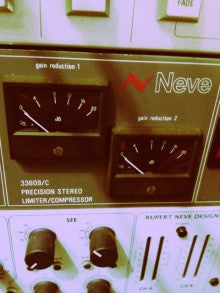
“NEVE33609 / C Type”
This is a classic compressor, and there are several types. I like the A type and C type. I’ll skip the details because otherwise this post will never end, but I really like this compressor.
It can be used for anything, but I mostly use it on drum parts and the stereo mix.
When it’s used on the stereo mix for rock music, it’s like, “Yes! That’s it!”
It’s hard to explain what “that” is, but it’s like when you eat plain rice and it’s delicious, and when you put an egg on it and it’s also delicious. But it’s similar to when I used to put “rice seasoning” that I often had at my parents’ house.
(This is just my personal impression.)
It gives a sense of completion.
There are no rules for using equipment like this, so I think it’s best to try it and find your own preferred way of using it.
Somehow, my head isn’t working today.
Or rather, my thoughts aren’t coming together.
But you know, that’s how life is.
[…]
[…]
Well, well, I thought I would talk about this one (the white one in the center),
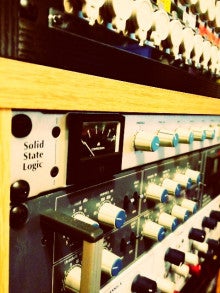
But for now, I have a different story to share. By the way, this is a compressor called “XLogic G Series Compressor.”
[…] (Comp talks about how his double bass got broken)
[…]
Well, well, in this livestream, I mainly play the acoustic guitar, but in the future, I’m thinking of playing bass and double bass as well~
But I think the acoustic guitar will appear more frequently, so today’s music equipment is this.
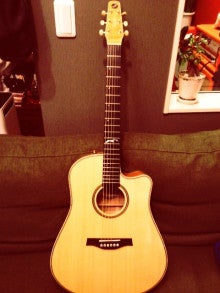

It’s an electro-acoustic guitar from a Canadian manufacturer called Seagull. An electro-acoustic guitar is an acoustic guitar with a pickup. Electric + Acoustic = Electro-Acoustic. That’s what it means. This won’t be on the exam.
I have a few other acoustic guitars as well, but this one, um… If I were to compare it…
It’s like when you’re walking on a narrow road and someone is approaching from the front. You think for about 0.2 seconds, “Which way should I move?” and then you quickly decide, “Okay, I’ll go right.” Then the other person does the same, and you end up repeating it 2-3 times, and then you go, “Ah… uh… haha…” Do you know what I mean?
Anyway, it’s an easy-to-handle and wonderful instrument.
As long as I’m satisfied with the equipment, everything is good!
[…]
[…]
And here is today’s music equipment.

It’s an effects pedalboard primarily used for electric bass in live performances.
Effects pedals are like blocks of metal that change the sound in various ways.
Basically, I play the bass and produce sound only with the bass and the amp, but sometimes I step on the effects pedals to add some flavor to the sound, like “swoooaaaan” or “wub wub wub.”
Then we have this.

This is an effects pedalboard for the double bass.
I always use both a preamp and a compressor, which are also metal blocks.
In other words, there are metal blocks all around my feet.
I’m rehearsing while stomping on these in preparation for the year-end live. Every day, while also working on Winter Comiket releases, LOL
[…]
[…]
Well, well, here is today’s music equipment.
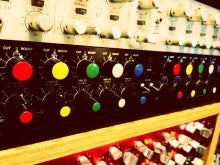
GML8200
This is an equalizer effect pedal that can boost or cut the lows, the highs, and the midrange frequencies.
This model has some variations depending on the era, but this is an early one.
Well, for those who don’t use recording equipment, it might be a bit puzzling, but since this one has colorful knobs, you could say it’s “cute.”
I mainly use it for stereo mix and mastering.
I’ll be using this while making the Winter Comiket albums, so I appreciate your patience.
[…]
[…]
Well, well, we’re currently right in the middle of production.
Today was Ranko’s vocal recording.

We recorded some great songs today as well.
It’s unrelated to the vocal recording, but today’s music equipment is here.
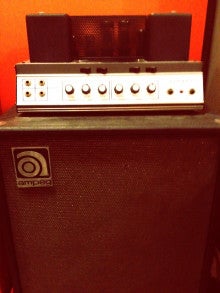
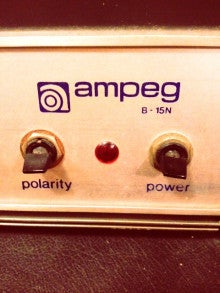
“Ampeg B-15N”
It’s a bass amp.
This one is from the late 1960s or early 1970s.
I’ve tried various amps for recording purposes, but this one is just right.
When I’m recording and thinking, “I want that amp sound~,” it delivers the sound that’s playing in my head.
Since it’s small, I use a different amp for live performances, but for recording, I’ve settled on this one (as of 2013).
[…]
On a serious topic, when I concentrate and work for several hours, there are times when I surpass something.
It’s like surpassing, or coming together.
It’s like when solder melts with a soldering iron, suddenly going “Wah!”
And then things progress in a really good way, whether it’s composing, arranging, or writing lyrics.
In my case, it’s easier to create that kind of feeling with hardware rather than software.
Not just guitars and basses, but also analog sound sources and hardware effects.
Today, I have one such item.

“Sid station” by Elektron
I love Elektron’s products, and I believe this was their first product.
Inside this silver box is a SID6581 chip, which is found in the Commodore 64 8-bit computer.
It may sound complicated, but basically, it’s gives the possibility to create similar sounds by putting that chip used in old computers into this box.
In simple terms, you can create sounds like those from the NES. The NES also has 8-bit sound.
I love this 8-bit sound and have collected various equipment for it, but the simulated sound is still quite different.
What’s different? The noise is intense LOL
Well, there are other differences as well, but including the noise, it’s user-friendly for me.
Simulated sounds are also well done, but they lack the instability that makes it difficult to achieve that melting point I mentioned earlier.
[…]
[…]
Here is today’s equipment.

Focusrite RED2
It’s an equalizer.
It’s a versatile tool that allows me to bring out a bit more of the high frequencies, or push the low frequencies further back.
I mainly use it on guitars.
It has a unique edge and allows for fine adjustments, so it’s convenient.
[…]
Here’s today’s equipment:


Stafford RSA-355
It’s what they call a semi-acoustic guitar.
This is the first guitar I bought with my own (earned) money.
I started playing bass right from the beginning, but it was convenient to be able to play at least some simple things on the guitar, so I would sometimes play around with my brother’s hand-me-down.
Eventually, I started feeling like I wanted my own guitar~ and I think the reason was that a semi-acoustic one could produce decent sound even without an amp.
I haven’t been using it much recently, but I’m glad I used it for the new album.
And the reaction from the other members was unexpectedly positive, like 700 times better than expected.
I think I’ll be using it more frequently from now on, probably.
Although polar bears aren’t the type to look back on the past too much, I’m glad I didn’t sell it now.
[…]
[…]
Well, well, here is today’s equipment.

Fender Custom Shop JB
This is from the Master Builder series, made by Mark Kendrick.
It’s my main bass for both live performances and recordings.
Originally, I was looking for a vintage JB bass, so I went to various shops and tried playing them. By chance, I came across this one and when I played it, it was a perfect match, so I bought it.
Since then, I’ve been using it all the time.
BUTAOTOME’s live performances are quite intense, so it has become quite worn out, but it’s an item that I really love.
Of course, I’ll be using this bass tomorrow as well.
[…]
[…]
Now, here is the first music equipment of 2014.
Bricasti Design M7


Taking a photo of it is tricky…
This is a reverb unit.
It can be applied to various sounds to create an expanded sense of space and add depth.
I’ve been using it in all of BUTAOTOME’s songs. It’s almost like the songs wouldn’t exist without this equipment, although it wasn’t there from the beginning (Touhou Kaiten Mokuba).
I wonder when I started using it~
I completely forgot LOL
I’ve always liked hardware for spatial effects, and before this, I used a Roland SRV3000.
Now, I find myself wanting to use the SRV3000 again~
There’s something different about using hardware compared to plugins.
Well, it’s obvious that they’re different.
But it’s such a hassle.
I say it every time, but it’s not about whether it’s good or bad, it just has to fit well for me.
[…]
[…]
So here is today’s music equipment.

UNIVERSAL AUDIO 1176AE
This is a compressor.
It’s a limited edition version that’s slightly different from the regular 1176.
Lately, I’ve been using it mainly for bass.
And also for Ranko’s live singing during our livestreams.
It’s a reincarnation of a legendary classic device, and it’s simply a solid block of user-friendly machinery.
Compared to other compressors, it’s incredibly easy to handle.
Having quick setup options for recording is actually a significant advantage.
[…]
[…]
And here is today’s music equipment.


Fender Custom Shop MBS Hollow PB
This is a Precision Bass from Fender Custom Shop’s Master Builder Series, built by Dennis Galuszka.
It has a hollow construction, as you can see in the second photo, with the interior being hollow.
I found this bass at a music store near the venue where we performed at the DJF live event in Osaka the other day.
I’ve been wanting a bass to use for the acoustic live performances we do during our weekly livestreams~ I had an ideal type in mind, and this bass came pretty close to that, so I took it home with me.
I’ll be playing it on our next album, and of course, I’ll be using it extensively during our live broadcasts.
It still has a young and vibrant sound, but I want to play it passionately and make it sound even better.
[…]
[…] (related picture below)

Now, as the feast is getting lively, this week’s music equipment is this one.
Stereo Variable Mu Limiter Compressor


This is the mastering version of that equipment.
It’s a classic piece of recording gear, commonly seen in mastering studios.
It’s a vacuum tube compressor that’s often described as something one can just pass the sound through and it will sound good.
In reality, just passing the sound through (without much compression) gives it a nice touch.
Well, when I say “nice touch,” it’s just my personal preference LOL
I don’t use it for heavy compression;
I mainly use it to add texture.
For BUTAOTOME, I always run the songs through this during mastering.
It’s a valuable piece of gear to have.
I’ve been introducing various equipment, but I feel like I haven’t explained much about the music itself…
But you see, It wouldn’t be very interesting if I wrote something like,
“This equipment gives the sound a slightly rounder tone with added depth and a touch of roughness, so when you use it on a certain genre, it sounds like blah blah blah…”
right?
It’s just my impression, you know.
Besides, it’s difficult to explain sound in words.
Everyone has different ears, and people have different opinions about sound.
So if you’re curious about what kind of sound it produces, please listen to BUTAOTOME’s music~
It’s like when you use various physical elements like bodies, blocks of wood, blocks of metal, and so on, it creates this kind of sound, that’s the feeling.
[…]
[…]
Now then, following all of that, today’s musical instrument is here.


GIBSON J-45
It’s a classic acoustic guitar, known for its distinctive sound.
Mine is not a vintage one, just a regular model from around 2008, I believe?
I don’t remember exactly, but I bought it brand new.
This guitar served as the main instrument for Acoustic Gakkyokushuu.
It’s very easy to use.
That’s probably why it has become a classic.
When I buy an acoustic instrument, I always play it myself first, and then I have the store clerk play it for me.
After that, I listen to how it sounds in the location where I’ll likely be placing a microphone, and if I think, “That sounds good!” I make the purchase.
Ideally, I would take it home and record with it before making the purchase, but that’s not really feasible, of course LOL
Acoustic instruments are different from electric ones; when you play them, the sound goes outwards, and you can’t hear how it sounds on the microphone side.
So, I went through that process and selected one from the eight J-45 guitars I had.
[…]
[…]
Well, well, in times like these, today’s music equipment is this:

AVALON M5
It’s the silver one in the middle.
This is a microphone preamp.
It allows me to record with a very clean sound. You often hear the term “clean sound” when talking about equipment, which means it has minimal coloration.
But even though it’s “minimal,” every piece of equipment still has its own character.
This is the sound that screams AVALON~~~~
Sorry…
It’s hard to explain LOL
Describing sounds with words is difficult, but it has a transparent quality to it.
I mainly use it when recording acoustic guitars or gut guitars.
I think many people also use it for female vocals.
Of course, one can use it for anything, but it’s not a very punchy piece of equipment, so I find it particularly suitable for recording acoustic instruments and clean voices.
I’ve been using it for the acoustic CDs we’ve been making recently, with acoustic guitars and gut guitars.
[…]
[…]
Today’s music equipment is here:

Bridgestone BLIZZAK VRX
This is an essential rubber loop for transporting equipment in the snow.
Just kidding, here It is:

AMPEX 350
This is its head amp section.
Originally, it was taken from a master tape deck that was popular in the 1960s and tuned to be used as a preamp.
It has big knobs and rugged meters, giving it a solid and chunky appearance, but surprisingly, the sound is clear.
Well, surprisingly, that is.
I often use it for recording guitar mics. Well, not often, but occasionally.
I don’t dislike it at all, it’s just that I don’t use it really often.
When I use this, it’s often a spontaneous thought like, “Oh, let’s use the AMPEX,” kind of mood.
The meters on this thing are cool~
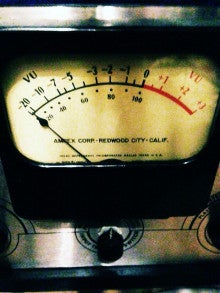
They are huge LOLOLOLOL
[…]
[…]
With that big pile of equipment, today’s music equipment is this:

SSL X Logic X-DESK
This is a mixer.
It can be used in various ways, but I mainly use it as a summing mixer.
Summing, well, I’d recommend asking Google-sensei for the technical details, but in essence, it’s a process of taking something recorded within the computer and sending it out temporarily before bringing it back into the computer.
To put it simply, let’s say you have separate tracks for drums, such as
– kick
– snare
– hi-hat
– tom-tom
– overhead, and so on. While you could mix them into a stereo mix within the computer, by using a summing mixer and sending them back into the computer, you can achieve better separation of sound, create a sense of depth, and add the coloring characteristics of the mixer. There are many wonderful things that can happen LOL
There are differing opinions on this technique, but I use it because I like the effects I can achieve.
In addition to this, I also use equipment from another manufacturer called API, depending on the purpose.
The X-DESK has a certain “guts” to it, or rather, it provides that solid, SSL-esque feeling when you mix with it.
Well, when I pass the audio through faders like these, it also adds to the excitement LOL
No, no, it also has musical significance, you know LOL
[…]
[…]
Well, well, there’s a mountain of things to write about, but this week’s musical instrument is this:


Rickenbacker 4003 MB
It’s a bass guitar.
I’ve been using it here and there in recent solo performances.
I use it when I want a rough and raw sound during recordings.
I think this one was made in 2001.
Rickenbacker bass guitars are by no means versatile.
Well, the appeal I feel lies in their looks and the way they can get wild.
And depending on the song, they can also produce a mellow sound, but that’s also a matter of personal preference.
I only play this bass with a pick.
And since I couldn’t achieve the desired sound with the original pickups, I replaced the rear pickup.
My main bass is a Fender Jazz Bass, but when I need the roughness, difficulty in control, and such that can’t be achieved with a Jazz Bass, I bring out this one.
I’ll continue using it in live performances here and there, so everyone, get rowdy too LOL
[…]
[…]
Well, well, it was such an unusual day, but today’s music equipment is this:

Divided by13
CJ-11 1×12Combo
It’s a guitar amplifier.
÷13 is the name of the manufacturer, and I think it’s pronounced “Divided 13.” Probably.
It’s one of those amps that are commonly referred to as boutique amps.
Well, all equipment is like that, but especially guitar amps have so many variations~~~~~~~!
In reality, they can be classified into British style or certain other styles, but if you look closely, there are so many, like, a lot~~~~~~~~~~~
Among them, this one is truly clean.
Well, the definition of “clean” varies from person to person, but when you play chords, each note stands out clearly.
In other words, it’s not easily disguised.
It gives a misty tone, too LOL
I use it when I want a punchy sound for recording.
However, I’m thinking of replacing it, so this might be the last time I can show it to you all LOL
Music equipment is all about using it.
The journey continues until you find something you can love for a lifetime.
[…]
[…]
Now I have replaced the bass I use for acoustic lives.


It’s a Carl Thompson bass.
I previously introduced the Fender Custom Shop bass in this blog.
I decided to replace it because it didn’t quite suit my purpose.
This bass has a longer neck than a regular bass.
It’s said to be not very suitable for Japanese people due to the length, but it’s not a problem for me as I am a polar bear and I have long hands.
The sound is very responsive.
The body is thinner compared to a Jazz Bass, for example, but it’s a lovely instrument with clear resonance from the wood.
Perhaps it’s because it’s carefully crafted in a small workshop?
There’s a certain handmade feel to it, in a good way.
[…]
[…]
And so, today’s music equipment is this.


DANGEROUS MUSIC BAX EQ
It’s an equalizer, but it’s a bit different from other equalizers.
Conventional EQs allow for fine adjustments and are excellent for corrections, but this one has a more general setting.
In fact, you operate it based on the values set by the manufacturer.
To be more specific, it can get complicated, so I’ll avoid going into details. But the reason why I like this equipment is that it can cut unnecessary frequencies!
And the way it cuts is very natural!
Plus, the phase is really good!
That’s why.
Oh, and it’s easy to use (intuitive) too!
Yes yes.
I want to create even better and more wonderful music with better sound quality, so I will continue to strive for improvement every day!
[…]
[…]
And today’s music equipment is this.

BOSS CE-1 Chorus Ensemble
It’s an effect pedal used for guitars and such.
It has chorus and tremolo functions.
It’s a somewhat old effect pedal, but it’s quite useful.
It has this quality of not getting drowned out by other sounds and provides a moderate amount of effects.
So, I’ve been using it quite a lot for the upcoming Reitaisai album.
[…]
[…]
Now then, today’s musical instrument is right here:

A mandolin.
I’ve always had trouble finding good mandolin sounds in the past.
So, I thought, why not learn to play it?
I bought it about 3 to 4 years ago.
The easiest song by BUTAOTOME to understand on the mandolin is probably the intro to “Bero Bero Be”~
I played that part.
I won’t be using it in tomorrow’s live performance, though. I’ll be playing other instruments like guitar and bass.
[…]
[…]
So, today’s music equipment is right here.

Chandler Limited GERMANIUM Pre amp V.I.R.mod
It’s the blue one on the second row.
This one has been modified with V.I.R.mod.
The modification allows me to create various sounds compared to the standard version.
This preamp is not essential, but it’s quite convenient to have.
At least for me.
I use it with bass, guitar, snare, and so on.
It has a sticky yet edgy sound, or I should say it’s edgy but not dry. Well, it’s a equipment with its own distinct character, so to speak.
I’ve been using it here and there in our upcoming Reitaisai release.
[…]
[…]
Well, today’s music equipment is right here.

Free The Tone BASS BLASTER
It’s an effects pedal for bass.
It has the function to distort the sound.
There are various distortion effects for bass, but this one is one of my favorites.
I use it for both recording and live performances.
Not for heavy distortion, but more like a slight hint of distortion.
Just enough to give it that edge, you know?
I’ll be using it in tomorrow’s live performance as well.
I’ve also used it in our new Reitaisai release.
I can’t wait for everyone to hear it~!
[…]
[…]
Now, today’s music equipment is right here.

NEUMANN TLM67
Well, it’s a microphone
And “Noiman” is how it’s pronounced.
Isn’t it fascinating?
I’ve mostly used this microphone for acoustic guitar.
When recording acoustic guitar, I tend to change microphones depending on the song, but I feel like I use this one more often for songs where the acoustic guitar needs to be upfront.
It’s not exceptionally outstanding, but it’s a perfectly fine microphone, no issues at all.
[…]
[…]
Now then, today’s music equipment is here.

Victor WOOD CONE
It’s a speaker.
It’s a sub-monitor that I use when mixing and mastering.
It’s more like a final check monitor, I guess.
The cone is made of wood.
It’s small and cute.
[…]
[…]
Now, today’s music equipment is here.

WalterWoods M450
It’s a bass amp.
I always use this amp head for live performances.
This amp is very responsive.
When it comes to bass, I’m not particularly fond of distorting it with the amp. Basically, I prefer using a straightforward amp with a solid core, and then I like to add distortion, dynamics, and play around with effects using my playing technique. So, this item satisfies my preferences.
It has two channels, but one of them is slightly broken.
I just need to replace the potentiometer, but since it’s an imported product, local music stores won’t take care of it.
Of course, I’ll be using this amp for this weekend’s live performance.
[…]
[…]
Now, today’s music equipment is here.

SENNHEISER e945
It’s a microphone.
This is the microphone I was using for recordings until recently.
I recorded almost all of my songs with this microphone.
I can’t remember exactly how many albums, but it’s quite a number of songs~
I thought this microphone was perfect for me and didn’t feel the need to change it for a long time. However, as the recording system changed and my desired sound evolved, I’m currently using a different microphone.
Even now, we use this microphone for our weekly live stream “BUTAOTOME Utau Namahousou.”
[…]
[…]
Well, well, May is coming to an end, but let’s introduce today’s music equipment.

SENNHEISER MD421
It’s commonly known as the “Whale” microphone.
It’s often used for recording purposes, such as capturing the sound of tom-toms in drums or amplifying guitars.
It can also be used for bass amps.
I personally only use it for guitars.
In the picture, you can see both the black and white versions. The black one is the newer model, while the white one is the older one.
I haven’t been using it much lately, but I used it quite a bit when I wanted to achieve a crunchy distortion sound.
I should try using it again.
[…]
[…]
Now, today’s music equipment is here.

UNIVERSAL AUDIO LA-3A
It’s the black one in the middle.
This is a compressor.
Lately, for recording Ranko’s songs, I’ve been using this 100% of the time.
I used to use a compressor called 1176, but I prefer this one because it has a smoother sound and I just like it better.
Changing the microphone also played a part in the decision.
I also use it for electric guitars and acoustic guitars, not just vocals, so I use it quite frequently.
[…]
[…]
And now, today’s music equipment is here.

Tube Tech PE1B
It’s an EQ.
I’ve replaced the internal vacuum tubes with TELEFUNKEN ones.
I use it a lot for bass.
What’s unique about this equipment is that it can simultaneously boost and cut frequencies in the same frequency range. But the reason I like it is because it’s “easy.”
I can’t make detailed adjustments with it, so I can quickly make decisions while listening to the sound.
And if it doesn’t fit the song, I can easily let go of it.
Something like that.
Well, that’s usually the advantage of outboard gear.
For me, it means it’s user-friendly, yes.
[…]
[…]
Well, well, with all that said and done, today’s music equipment is here.


Thermionic Culture Phoenix
This one has been customized by TONEFLAKE, and it has a very fat sound.

It’s a compressor.
I don’t use it very frequently, but I remember using it a lot on kicks and synths.
I might also use it on the drum stereo mix.
Well, it’s fat.
I might not have fully mastered it yet.
I plan to continue exploring and experimenting with it more!
[…]
[…]
Well, well, there are various events happening, but currently, I’m right in the middle of C86 releases production.
There’s some equipment I’m heavily using.
Here it’s today’s music equipment:


AVALON AD2055
It’s an equalizer.
I use it a lot for the piano.
It’s a very transparent equalizer that adds a sparkling quality to the piano’s high frequencies.
I occasionally use it for vocals too.
[…]
[…]
Now, let’s talk about the music equipment that will be heavily used during fun time.


Portico II Master Buss Processor
It’s a compressor.
(The white one in the middle)
This is mainly used for the stereo mix.
It’s a relatively recent release, so the sound is clear.
However, it bears the name of NEVE, so I can also create slightly edgier sounds.
In that sense, it’s also user-friendly.
You can control the depth and width as well.
The sidechain is also spot-on.
Well, I’m still far from the mixing stage, but I hope the day comes when I can use this soon.
[…]
[…]
And here is today’s music equipment.

OYAIDE / Black Mamba-α
It’s a power cable.
Some of you may be wondering what it is, but power cables are important, you know LOL
About 70% of the equipment in the Butagoya Studio is using this cable.
I don’t want everything to be too similar, so the remaining 30% is using cables with different characteristics.
This cable offers excellent cost performance and doesn’t have strong characteristics, so I have set up a lot of them.
[…]
[…]
Well, well, with all that being said, here is today’s equipment.

PS Audio NOISE HARVESTER
It’s for the power supply area.
Well, it’s not exactly a piece of equipment LOL
It’s a device that absorbs power supply noise just by plugging it into an available socket.
And when it absorbs noise, an LED lights up.
Basically, it lights up when there’s noise to absorb and remains dark when there isn’t.
I introduced a power cable the other day, but the power supply is important in recording, yes indeed.
It’s even a niche genre in itself…
Well, within my capabilities, of course. This one seemed quite good, so I decided to incorporate it.
It may seem inconspicuous, but the accumulation of inconspicuous things is everything~.
[…]
[…]
Here is today’s music equipment.

Oops, I made a mistake on purpose.
This artwork is incredibly cool.
Okay, here it is:

PETE CORNISH ACOUSTIC PREAMP/DI/MUTE
It’s a preamp DI used for the double bass.
Well, not just used, but I have been using it since this recording session.
It took about three months to finally get it.
That’s why I haven’t been able to use it for live performances yet.
The preamp I used before was also good, but this one is the best.
What makes it the best? It’s simple!
I personally prefer simple equipment.
Of course, the sound is excellent as well.
No matter how simple it is, if the sound is not good, it’s not worth using.
It’s simple, yet it has the tuner out that I wanted, so it’s perfect.
A new double bass has also arrived.
It’s exactly the same as the previous one.
But it took about 4 to 5 months for it to arrive.
I bought it brand new, but there were some minor issues, so there was a plan to exchange it for a new one. However, there were some political issues or something related to overseas products, so the shipment got delayed for various reasons.
So, the fun time continues, but we’re creating a super happy album. Please wait for it, everyone.
[…]
[…]
Here is today’s music equipment.


TECH21 SansAmp PSA-1
This is a guitar amp amp simulator, but I use it to distort vocals or as a special effect tool.
I also use it to add distortion and layer it on top of the original track.
I tried various methods with other equipment, but the PSA-1 is still the best.
It seems that it is still being sold brand new, but mine is quite old, so the program conversion switch is a bit erratic. However, I can still use it without any issues.
[…]
[…]
Now, let’s take a look at some of the music equipment used in the new releases.

Roland TR-8
It’s a rhythm machine.
It contains drum sounds, and one can create rhythms using this machine alone. However, I use it as a sound source.
It has a sound that resonates with me because Roland released it with the same sound as the legendary drum machines like Roland TR-808 and TR-909.
Thanks to it, my desk has become crowded once again.
[…]
[…]
Now, now, with all that said and done, let’s take a look at today’s music equipment.


Rupert Neve Designs – Portico 5033
It’s an equalizer.
I used it extensively for the bass in these albums.
When I say extensively, I don’t mean I drastically changed the sound, but rather made slight adjustments.
It’s incredibly user-friendly.
Especially for the bass.
I occasionally use it for vocals, but never for guitar, personally.
It adds a touch of color, but rather than seeking the signature NEVE sound, it provides a clear and natural EQ curve that is easy to work with, specifically for the bass.
I always say this, but it’s my personal preference.
So, for me, this EQ is easy to use when mixing with my bass. That’s what I mean.
I can give you a proper review! Absolutely!
But not in this blog, you know.
[…]
[…]
To accomplish various tasks, today’s essential music equipment is right here.

PRISM SOUND Orpheus
It’s an audio interface.
Without it, I can’t record sound into my computer or listen to recorded audio.
It’s indispensable for any serious work.
I’ve used several audio interfaces in the past, but for the sake of avoiding excuses, I chose this one.
Of course, I’m pleased with its sound as well.
Unless I significantly expand the studio, I plan to continue using this.
[…]
[…]
Now, with all that said and done, today’s music equipment is right here.

Roland SYSTEM-1
It’s a synthesizer.
This one is super modern.
I can quickly and easily create sounds with it.
It’s affordable and easy to understand for learning synth sounds.
Even if you don’t know much about synthesizers, you can still have fun with it.
Truly a modern tool.
And the sound is, of course, good.
I haven’t fully explored its capabilities yet, but I’ve already used it in the songs I’m currently working on.
[…]
[…]
So, with that being said, today’s music equipment is right here.


moog
Little Phatty Stage 2
It’s a synthesizer.
When it comes to synthesizers, Moog is the name that comes to mind.
I’ve admired Moog since I was a cub.
Well, this is a contemporary model of that classic synthesizer.
I used to have other older Moog synthesizers, but for stage performances, I wanted something stable and reliable. So now, I only have this Moog one.
It produces sounds like “wee wee wee boo”.
I personally enjoy using such hardware instruments (not software). I always think, “Oh, it’s troublesome,” while playing them.
Software instruments can do everything within the computer, and they are extremely convenient. I could just use software, but despite the “troublesome” aspect, I still prefer hardware instruments.
Of course, I also like the sound, but it’s hard to explain.
It’s not just about the individual sound; there’s something different when it blends with other instruments.
Perhaps the feeling is different because I push through the “troublesome” part and play it LOL
Lately, I’ve been even more focused on “expressing something through the sound,” so it’s even more pronounced.
I’m not a banana.
[…]
[…]
With all that said, today’s music equipment is right here.

Gibson / Custom Shop Historic Collection Flying V
It’s a guitar.
I think I bought this one over 10 years ago.
I’m not really good at remembering those things.
When I tried playing it at the music store, I thought, “Ah, this is nice!” and decided to buy it.
I don’t use it very often, but when I leave it untouched for a while and then pick it up again, it’s like, “Ah, this is nice!”
In the image swirling around in my mind, I feel like I’ll be using it more frequently in the future.
I want to continue striving every day with the motto of “Bringing the true joy of music closer.”
[…]
[…]
Well, well, amidst such daily life, today’s music equipment is right here.

DigiTech Whammy
It’s still available for purchase, but this is the first-generation model.
This Whammy pedal feels the most comfortable to me.
I haven’t tried them all, so there might be something better out there LOL
I used it in BUTAOTOME’s song “Nani mo nai Mori”.
On the bass.
I think I want to use this for various things in the future, but I haven’t quite figured out how to incorporate it into my effects board for live performances yet…
[…]
[…]
Now, with all that said and done, today’s music equipment that I put my heart and soul into is here.

Gibson Thunderbird
This bass is the oldest one among the ones I currently own.
It’s the third bass I ever owned in my huma- ehm, bear life.
I think I probably sold the first and second ones.
This bass had been stored in my warehouse for a long time, but yesterday I brought it home, changed the strings, and gave it a test play.
It actually sounds pretty good, but its condition is definitely not great.
Or rather, back in the day, I used to raise the action of the strings ridiculously high when playing, so the neck might be beyond repair.
I have many memories of practicing the basics to death on this bass.
While changing the strings, I found myself reminiscing about those old times.
Perhaps the reason I brought this bass home was not to use it, but to remind myself of those simple days when everything started.
God can be tricky to understand.
[…]